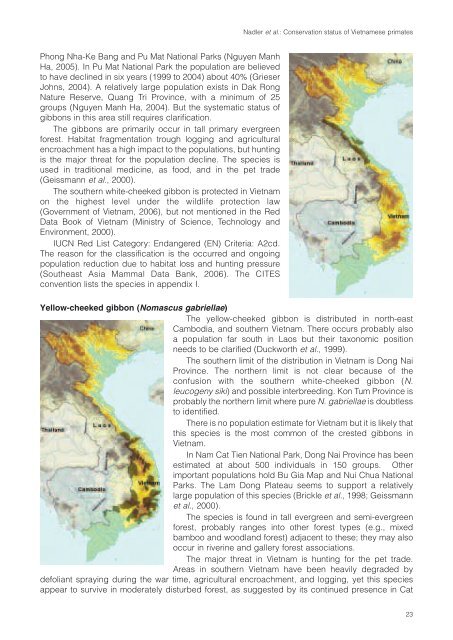Vietnamese Journal of Primatology - Frankfurt Zoological Society
Vietnamese Journal of Primatology - Frankfurt Zoological Society
Vietnamese Journal of Primatology - Frankfurt Zoological Society
Create successful ePaper yourself
Turn your PDF publications into a flip-book with our unique Google optimized e-Paper software.
Phong Nha-Ke Bang and Pu Mat National Parks (Nguyen Manh<br />
Ha, 2005). In Pu Mat National Park the population are believed<br />
to have declined in six years (1999 to 2004) about 40% (Grieser<br />
Johns, 2004). A relatively large population exists in Dak Rong<br />
Nature Reserve, Quang Tri Province, with a minimum <strong>of</strong> 25<br />
groups (Nguyen Manh Ha, 2004). But the systematic status <strong>of</strong><br />
gibbons in this area still requires clarification.<br />
The gibbons are primarily occur in tall primary evergreen<br />
forest. Habitat fragmentation trough logging and agricultural<br />
encroachment has a high impact to the populations, but hunting<br />
is the major threat for the population decline. The species is<br />
used in traditional medicine, as food, and in the pet trade<br />
(Geissmann et al., 2000).<br />
The southern white-cheeked gibbon is protected in Vietnam<br />
on the highest level under the wildlife protection law<br />
(Government <strong>of</strong> Vietnam, 2006), but not mentioned in the Red<br />
Data Book <strong>of</strong> Vietnam (Ministry <strong>of</strong> Science, Technology and<br />
Environment, 2000).<br />
IUCN Red List Category: Endangered (EN) Criteria: A2cd.<br />
The reason for the classification is the occurred and ongoing<br />
population reduction due to habitat loss and hunting pressure<br />
(Southeast Asia Mammal Data Bank, 2006). The CITES<br />
convention lists the species in appendix I.<br />
Nadler et al.: Conservation status <strong>of</strong> <strong>Vietnamese</strong> primates<br />
Yellow-cheeked gibbon (Nomascus gabriellae)<br />
The yellow-cheeked gibbon is distributed in north-east<br />
Cambodia, and southern Vietnam. There occurs probably also<br />
a population far south in Laos but their taxonomic position<br />
needs to be clarified (Duckworth et al., 1999).<br />
The southern limit <strong>of</strong> the distribution in Vietnam is Dong Nai<br />
Province. The northern limit is not clear because <strong>of</strong> the<br />
confusion with the southern white-cheeked gibbon (N.<br />
leucogeny siki) and possible interbreeding. Kon Tum Province is<br />
probably the northern limit where pure N. gabriellae is doubtless<br />
to identified.<br />
There is no population estimate for Vietnam but it is likely that<br />
this species is the most common <strong>of</strong> the crested gibbons in<br />
Vietnam.<br />
In Nam Cat Tien National Park, Dong Nai Province has been<br />
estimated at about 500 individuals in 150 groups. Other<br />
important populations hold Bu Gia Map and Nui Chua National<br />
Parks. The Lam Dong Plateau seems to support a relatively<br />
large population <strong>of</strong> this species (Brickle et al., 1998; Geissmann<br />
et al., 2000).<br />
The species is found in tall evergreen and semi-evergreen<br />
forest, probably ranges into other forest types (e.g., mixed<br />
bamboo and woodland forest) adjacent to these; they may also<br />
occur in riverine and gallery forest associations.<br />
The major threat in Vietnam is hunting for the pet trade.<br />
Areas in southern Vietnam have been heavily degraded by<br />
defoliant spraying during the war time, agricultural encroachment, and logging, yet this species<br />
appear to survive in moderately disturbed forest, as suggested by its continued presence in Cat<br />
23
















